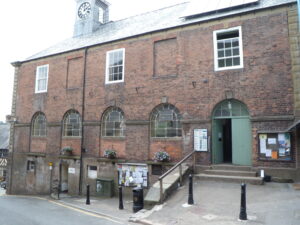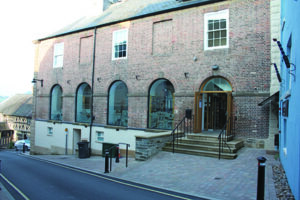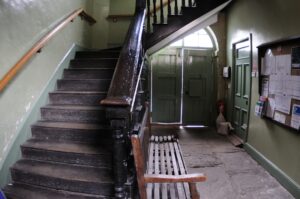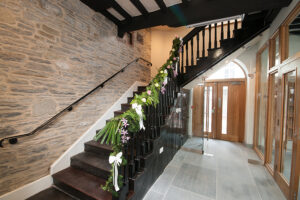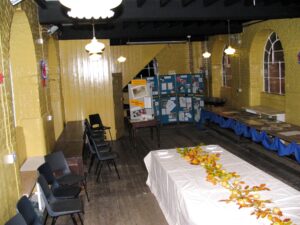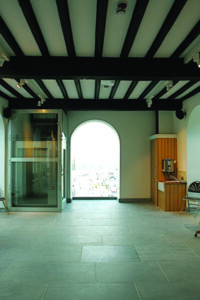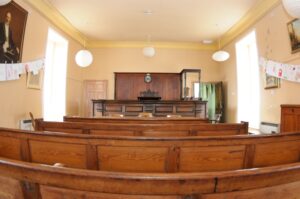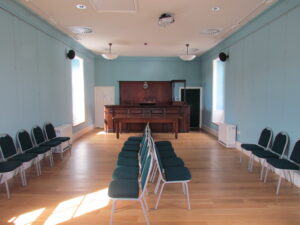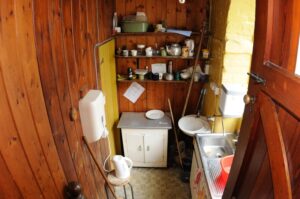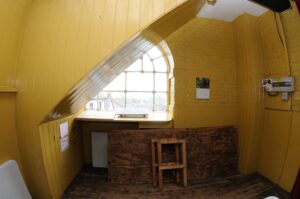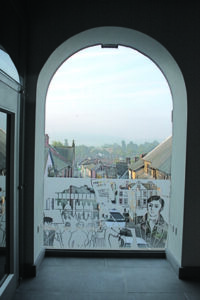Background
Dominating the steep High Street, the Grade II* listed Town Hall has been central to Bishop’s Castle’s civic, social, economic and cultural life for over 250 years. Once every few generations or so it was altered or repaired to suit contemporary needs: the original open arches were infilled; the whole basement was converted to provide public conveniences; crumbling stone work was encased in cement; and a second staircase inserted to serve the magistrates’ court. Towards the close of the 20thC, the building was tired, cold and draughty, its architectural impact was diminished and due to access limitations, its civic role was under threat.
The Community Response
For over a decade the Town Council, supported by groups interested in tourism, enterprise and the built heritage, made repeated attempts to secure significant grant funding for a major renovation. In 2009, shortly after another rejection, they invited Bishop’s Castle Heritage Resource Centre (BCHRC) volunteers to review the issues. BCHRC had recently been established through a 2003 Heritage Lottery Fund (HLF) award to the House on Crutches Museum Trust. The advice came back that the Council had to demonstrate the importance of the Town Hall to the local community and how a well-designed renovation would increase access to its heritage. Two years of community consultation, fundraising events and school visits, helped by the generous pro bono input of key experts, produced a successful ‘first round’ HLF bid in 2011. This enabled the Council to take on architect, Philip Belchere and project manager, Sam Hine. With the volunteer project team, they developed the project to the final HLF bid stage, bringing in additional funding from The Pilgrim Trust, Shropshire Council and Shropshire Hills Leader Programme (EU funds). The local community also raised over £60,000, helping secure the award of £676,800 from the HLF.
The Renovation Plan
A Condition Survey confirmed that whilst the building’s basic structure was sound, previous interventions had damaged its fabric, reducing both its sustainability and aesthetic appeal. Extensive cement render and pointing was retaining moisture, damaging the fabric and adding to the chill caused by ill-fitting doors and windows and inadequate heaters. Access for anyone with mobility issues (or a pushchair!) was challenging, and for someone using a wheelchair it was impossible. The plans addressed all these issues, dramatically reversing previous changes: reopening the arches completely with double glazed windows; replacing the disfiguring secondary staircase with a glass lift shaft from basement to Council chamber, providing full accessibility; breathable insulation throughout, underfloor heating beneath new stone slabs to basement and hall, with storage heaters on the top floor would ensure comfort, and complement pre-installed roof-top PV panels. The works contract was awarded to J Harper and Sons of Leominster in early 2013. Work began in June.
During the Renovation
There was an unexpected delay caused by the discovery that most of the original construction of the market hall floor – oak beams, covered with elm planks on which thick stone flags were laid – had been replaced at some stage by a thick concrete slab – hidden by a floating wooden floor. Engineers were consulted and it was decided to completely remove it. This opened up a view of the stripped basement area – the former town gaol – not seen in many generations. Public viewings were arranged during national Heritage Open Days in 2013. A photographic log records many striking before-and-after contrasts. Meanwhile its historic roles were researched and shared.
Going Forward
Opened in 2014, the renovated Town Hall has a new lease of life providing visitor information. The dramatic ‘open’ arches have reconnected the building to its stunning surroundings, enchanting visitors and locals alike, who receive a warm welcome from staff and volunteers 5 days a week. Still home to the Town Council, it hosts a wide range of public and private events from talks, concerts, markets and workshops to weddings and wakes. And it now has a major role in the local heritage network, used by many groups to share the history of this unique border town. Reflecting its enhanced role at the heart of the community, increased public access is managed by a new charity, the Town Hall Trust, on which the Town Council and local tourism and heritage organisations are equally represented.
